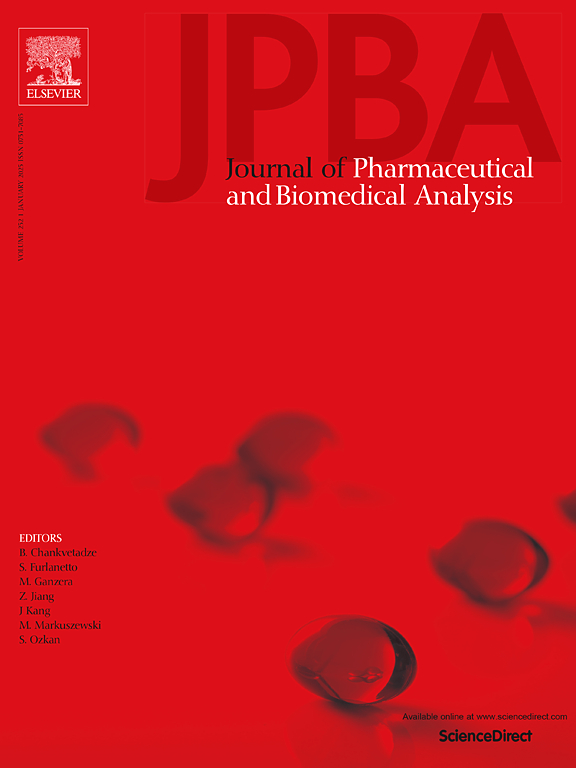干血斑中四种内源性大麻素及其同系物与δ -9四氢大麻酚及其相关代谢物的同时分析
IF 3.1
3区 医学
Q2 CHEMISTRY, ANALYTICAL
Journal of pharmaceutical and biomedical analysis
Pub Date : 2025-05-26
DOI:10.1016/j.jpba.2025.116991
引用次数: 0
摘要
在医学领域,由于科学和媒体的原因(大麻、大麻二酚等),内源性大麻素系统既是一个困难的话题,也是一个热门话题。由于内源性大麻素在血液中的不稳定性和低浓度以及其物理化学性质,其测定的复杂性在不同基质中已有报道。本研究旨在建立同时定量测定四种内源性大麻素及其同源物的LC-MS/MS方法:n -花生四烯酰基乙醇酰胺(anandamide或AEA)、2-花生四烯酰基甘油/1-花生四烯酰基甘油(2-AG/1-AG)、油基乙醇酰胺(OEA)和棕榈酰乙醇酰胺(PEA),以及Δ9-tetrahydrocannabinol (THC)及其主要代谢物[11-no -9-羧基-Δ9-tetrahydrocannabinol (THC- cooh)和11-羟基-Δ9-tetrahydrocannabinol (11-OH THC]在干血斑(DBS)中的作用。该方法的检出限为0.1 µg/L, THC和11-OH THC检出限为0.5 µg/L, OEA、PEA、2AG和THC- cooh检出限为1 µg/L。该方法在定量限内和测定间的准确度和精密度小于20 %,在其他校准点的准确度和精密度小于15 %。特别是本研究中所进行的稳定性研究,证明了DBS在全血中内源性大麻素测定中的实用性。因此,我们建议将这种方法作为基础和临床研究的工具,以支持科学界对内源性大麻素系统日益增长的兴趣。本文章由计算机程序翻译,如有差异,请以英文原文为准。
Simultaneous analysis of four endocannabinoids and endocannabinoid congeners together with delta-9 tetrahydrocannabinol and related metabolites in dried blood spots
In the medical field, the endocannabinoid system is both a difficult and hot topic for scientific and media reasons (cannabis, cannabidiol, etc.). Due to their instability and low concentrations in blood and physicochemical properties, the complexity of endocannabinoid assay is previously reported in different matrices. This study aims to report a LC-MS/MS method for the simultaneous quantification of four endocannabinoids and endocannabinoid congeners: N-arachidonoylethanolamide (anandamide or AEA), 2-arachidonoylglycerol/1-arachidonoylglycerol (2-AG/1-AG), oleoylethanolamide (OEA) and palmitoylethanolamide (PEA), together with Δ9-tetrahydrocannabinol (THC) and its main metabolites [11-nor-9-carboxy-Δ9-tetrahydrocannabinol (THC-COOH) and 11-hydroxy- Δ9-tetrahydrocannabinol (11-OH THC] in Dried Blood Spot (DBS). This validated method reported LLOQs of 0.1 µg/L for AEA, 0.5 µg/L for THC and 11-OH THC, and 1 µg/L for OEA, PEA, 2AG and THC-COOH. The method demonstrated intra- and interassay accuracy and precision of less than 20 % for the LLOQ, and less than 15 % for the other calibration points. In particular, the stability carried out in this study demonstrated the practical applicability of DBS for the measurement of endocannabinoids in the whole blood. Therefore, we propose this method as a tool for basic and clinical research to support the growing interest of the scientific community in the endocannabinoid system.
求助全文
通过发布文献求助,成功后即可免费获取论文全文。
去求助
来源期刊
CiteScore
6.70
自引率
5.90%
发文量
588
审稿时长
37 days
期刊介绍:
This journal is an international medium directed towards the needs of academic, clinical, government and industrial analysis by publishing original research reports and critical reviews on pharmaceutical and biomedical analysis. It covers the interdisciplinary aspects of analysis in the pharmaceutical, biomedical and clinical sciences, including developments in analytical methodology, instrumentation, computation and interpretation. Submissions on novel applications focusing on drug purity and stability studies, pharmacokinetics, therapeutic monitoring, metabolic profiling; drug-related aspects of analytical biochemistry and forensic toxicology; quality assurance in the pharmaceutical industry are also welcome.
Studies from areas of well established and poorly selective methods, such as UV-VIS spectrophotometry (including derivative and multi-wavelength measurements), basic electroanalytical (potentiometric, polarographic and voltammetric) methods, fluorimetry, flow-injection analysis, etc. are accepted for publication in exceptional cases only, if a unique and substantial advantage over presently known systems is demonstrated. The same applies to the assay of simple drug formulations by any kind of methods and the determination of drugs in biological samples based merely on spiked samples. Drug purity/stability studies should contain information on the structure elucidation of the impurities/degradants.

 求助内容:
求助内容: 应助结果提醒方式:
应助结果提醒方式:


